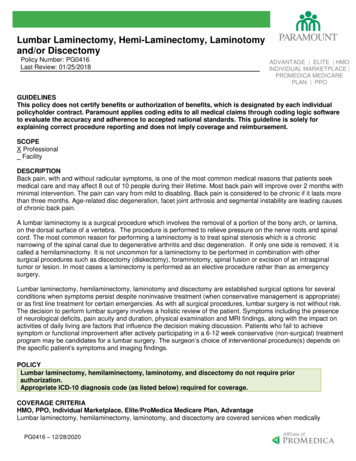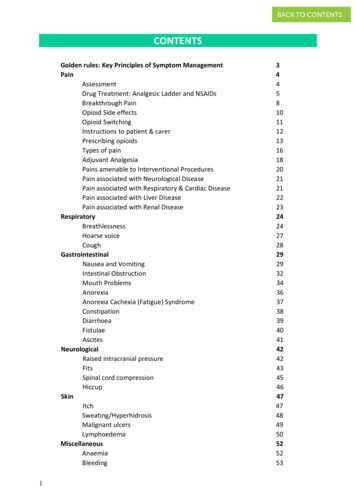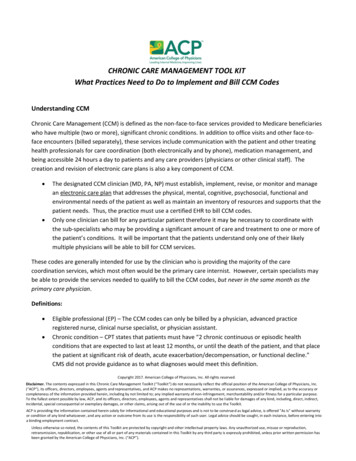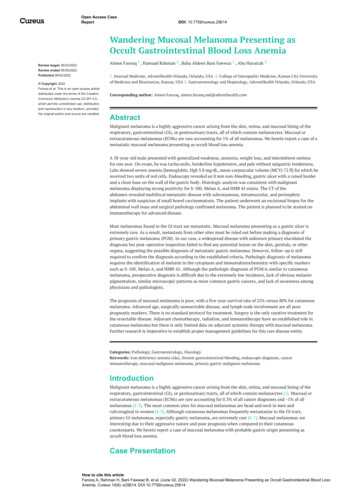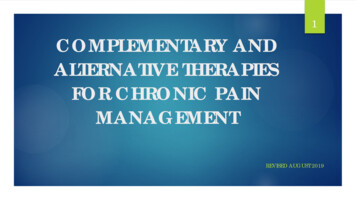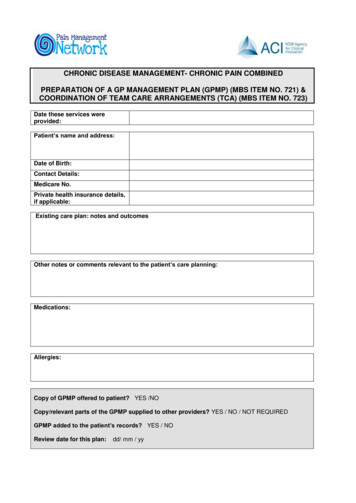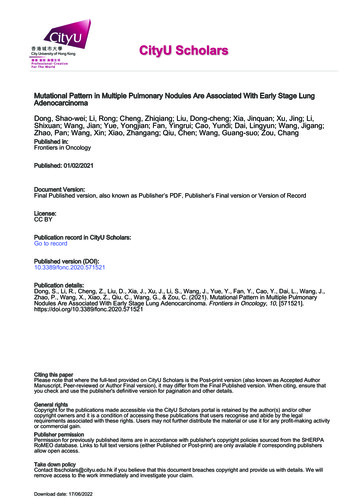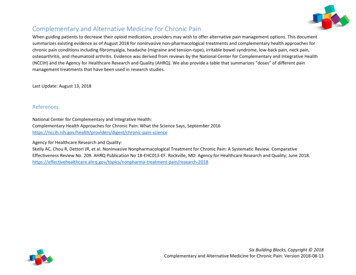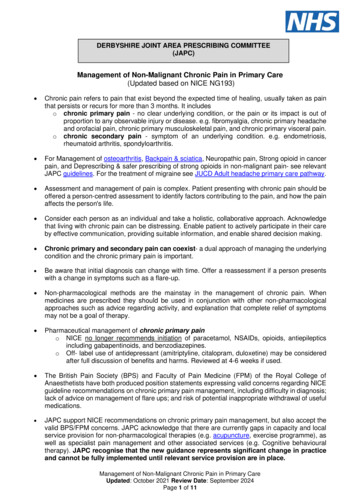
Transcription
DERBYSHIRE JOINT AREA PRESCRIBING COMMITTEE(JAPC)Management of Non-Malignant Chronic Pain in Primary Care(Updated based on NICE NG193) Chronic pain refers to pain that exist beyond the expected time of healing, usually taken as painthat persists or recurs for more than 3 months. It includeso chronic primary pain - no clear underlying condition, or the pain or its impact is out ofproportion to any observable injury or disease. e.g. fibromyalgia, chronic primary headacheand orofacial pain, chronic primary musculoskeletal pain, and chronic primary visceral pain.o chronic secondary pain - symptom of an underlying condition. e.g. endometriosis,rheumatoid arthritis, spondyloarthritis. For Management of osteoarthritis, Backpain & sciatica, Neuropathic pain, Strong opioid in cancerpain, and Deprescribing & safer prescribing of strong opioids in non-malignant pain- see relevantJAPC guidelines. For the treatment of migraine see JUCD Adult headache primary care pathway. Assessment and management of pain is complex. Patient presenting with chronic pain should beoffered a person-centred assessment to identify factors contributing to the pain, and how the painaffects the person's life. Consider each person as an individual and take a holistic, collaborative approach. Acknowledgethat living with chronic pain can be distressing. Enable patient to actively participate in their careby effective communication, providing suitable information, and enable shared decision making. Chronic primary and secondary pain can coexist- a dual approach of managing the underlyingcondition and the chronic primary pain is important. Be aware that initial diagnosis can change with time. Offer a reassessment if a person presentswith a change in symptoms such as a flare-up. Non-pharmacological methods are the mainstay in the management of chronic pain. Whenmedicines are prescribed they should be used in conjunction with other non-pharmacologicalapproaches such as advice regarding activity, and explanation that complete relief of symptomsmay not be a goal of therapy. Pharmaceutical management of chronic primary paino NICE no longer recommends initiation of paracetamol, NSAIDs, opioids, antiepilepticsincluding gabapentinoids, and benzodiazepines.o Off- label use of antidepressant (amitriptyline, citalopram, duloxetine) may be consideredafter full discussion of benefits and harms. Reviewed at 4-6 weeks if used. The British Pain Society (BPS) and Faculty of Pain Medicine (FPM) of the Royal College ofAnaesthetists have both produced position statements expressing valid concerns regarding NICEguideline recommendations on chronic primary pain management, including difficulty in diagnosis;lack of advice on management of flare ups; and risk of potential inappropriate withdrawal of usefulmedications. JAPC support NICE recommendations on chronic primary pain management, but also accept thevalid BPS/FPM concerns. JAPC acknowledge that there are currently gaps in capacity and localservice provision for non-pharmacological therapies (e.g. acupuncture, exercise programme), aswell as specialist pain management and other associated services (e.g. Cognitive behaviouraltherapy). JAPC recognise that the new guidance represents significant change in practiceand cannot be fully implemented until relevant service provision are in place.Management of Non-Malignant Chronic Pain in Primary CareUpdated: October 2021 Review Date: September 2024Page 1 of 11
Table of ContentsPage1. Introduction32. Patient centred assessment43. Non-pharmacological interventions54. Pharmacological management of chronic primary pain65. Existing treatment for chronic primary pain86. Criteria for referral to pain clinic8ResourcesUseful contacts99Appendix 1 North Derbyshire pain management programme referral10Reference1. NICE NG193 https://www.nice.org.uk/guidance/ng1932. CKS Chronic pain pain https://cks.nice.org.uk/topics/chronic-pain/3. The British Pain Society https://www.britishpainsociety.org/4. Faculty of Pain Medicine of the Royal College of Anaesthetists https://fpm.ac.uk/5. NICE NG144 Cannabis-based medicinal products. https://www.nice.org.uk/guidance/ng144Document controlManagement of Non-Malignant Chronic Pain in Primary CareUpdated: October 2021 Review Date: September 2024Page 2 of 11
1. IntroductionThis guideline is based on NICE NG193 and aims is to provide guidance for primary care clinicianson the management chronic pain, with specific focus on the management of chronic primary pain.In the UK the prevalence of chronic pain is uncertain, but appears common, estimated to affectbetween 3- 5 in every 10 people. It is not known what proportion of people with chronic pain eitherneed or wish for treatment. The prevalence of chronic primary pain is unknown but is estimated to bebetween 1% and 6% in England.DefinitionsChronic painPain that persists for more than 3 monthsOther terms used include persistent pain and long-term pain.Chronic primary painChronic secondary painHas no clear underlying condition or is out ofproportion to any observable injury or disease.Symptom of an underlying conditionThe mechanisms underlying chronic primary painare only partially understood and the definitions arefairly new. The clinical presentation is consistentwith the ICD-11 definition.All forms of pain can cause distress and disability,but these features are particularly prominent inpresentations of chronic primary pain.e.g. Fibromyalgia (chronic widespread pain) chronic primary headache and orofacialpain chronic primary musculoskeletal pain chronic primary visceral pain.e.g. Endometriosis Headaches IBS (local guideline) low back pain & sciatica (localguideline) neuropathic pain (local guideline) osteoarthritis (OA) (localguideline) rheumatoid arthritis (RA) spondyloarthritis.Chronic secondary pain and chronic primary pain can coexist.Diagnosis can change with time. Offer reassessment if a person presents with flare-up.Flare-upA sudden, temporary worsening of symptoms. Usually this refers to more intense pain on aday‑to‑day basis. It can also refer to a change in fatigue, stiffness, function or disease activity.Flare‑ups can be unpredictable and the time they last can vary.Management of Non-Malignant Chronic Pain in Primary CareUpdated: October 2021 Review Date: September 2024Page 3 of 11
2. Patient-centred AssessmentOffer a patient centred assessment to identify factors contributing to the pain. The assessment ofchronic pain needs to be wide-ranging and comprehensive.Recognise that chronic primary pain can coexist with chronic secondary pain, and that initial diagnosismay change with time. Ask the person (and their family/carers) to describe how chronic pain affects their life, and howaspects of their life may affect their chronic pain. This may include:o Lifestyle and day-to-day activities, including work and sleep disturbanceo physical and psychological wellbeingo stressful life events, including previous or current physical or emotional traumao current or history of substance misuseo social interaction and relationshipso difficulties with employment, housing, income, and other social concerns.Ask about the person's (and their family/carer) understanding of their condition including causes ofthe pain, expectations, and outcome of possible treatments.Explore a person's strengths as well as the impact of pain on their life.In young adults aged 16-25 years, consider age-related differences in presentation of symptoms,the impact of pain on family interactions/ dynamics, education, and social/ emotional development. Providing information and developing care & support plan Acknowledge that living with pain can be distressing. Consider each person as an individual and take a holistic, collaborative approach. Enable patientto actively participate in their care by effective communication, providing suitable information (inappropriate format e.g. written, verbal, video etc.), and enable shared decision making. Be sensitive to the risk of invalidating the person's experience of chronic pain when communicatingnormal or negative test results. Explain the evidence for possible benefits, risks, and uncertainties of all management options toinform and agree the care and support plan. Offer a reassessment if a person presents with a change in symptoms such as a flare-up ofchronic pain. Review the care & support plan, consider investigating & managing any newsymptoms, and discuss what might have contributed to the flare-up (but be aware that a causefor the flare-up may not be identified).Discuss the following adviceDevelop plan symptoms will fluctuate over time and thatthey may have flare-upsa reason for the pain (or flare-up) may not beidentified, and the pain may not improve ormay get worse and may need ongoingmanagementthere can be improvements in quality of lifeeven if the pain remains unchanged. explore their priorities, abilities and goalswhat they are already doing that is helpfultheir preferred approach to treatment andbalance of treatments for multiple conditionsany support needed for young adults (aged16 to 25) to continue with their education ortraining, if this is appropriate.Management of Non-Malignant Chronic Pain in Primary CareUpdated: October 2021 Review Date: September 2024Page 4 of 11
3. Non-pharmacological InterventionsNon-pharmacological methods are the mainstay in the management of chronic pain. The generalprinciples include: Activity: the evidence shows that keeping active improves both physical and mental well-being.Being active when in pain can be a challenge and it is therefore important for patients to know thatit is safe to be active in spite of pain; provide reassurance that pain does not always indicate harmespecially when pain persists for a long time.For some patients, weight loss may improve outcomes; support for assistance with weight lossefforts is available from: https://www.livelifebetterderbyshire.org.uk/ Encourage self-management: Self-management can be used from the early stages ofmanagement through to long-term management and can complement other therapies. Understandthat Medicines are generally less effective for persistent pain than for other types of pain. Whenmedicines are prescribed, they should be used in combination with other treatment approaches tosupport improved physical, psychological and social functioning. Provide advice and informationabout diet, weight, alcohol use, smoking, and exercise for improving or maintaining health. Understanding pain: Persistent non-cancer pain is influenced not only by tissue injury but by anumber of emotional, social and cognitive variables. Psychoeducation around pain mechanismscan help to reduce the experience of psychological threat. Fear is a major driver that can contributeto persistent pain. Education helps reduce fear, promote understanding and resilience, and enablerecovery of confidence and activity. Every clinical interaction has the potential to do this. It isimportant that patients with chronic pain understand that treatments tend not to be very effectiveand that the aim is to support them in functioning as well as possible. (FPM) Psychological approaches: the evidence shows that pain is associated with anxiety and stress;therefore, it may be helpful to use relaxation techniques and/or psychological approaches (suchas cognitive behavioural therapy) to help to manage the pain. High levels of anxiety, stress andpain may lead to sleep disturbance; hence, sleep restoration strategies may also be helpful.This section represents a very brief overview of non-pharmacological management of chronic painand, if the GP requires more detailed assessment and treatment, then a referral to specialistservices, such as the pain clinic, the physiotherapy service, a pain management programme(for group-based management of mood and activity) or the Health Psychology Service (formanagement of mood, adjustment and coping issues) is strongly recommended.For the management of chronic primary pain, NICE recommends Offer supervised group exercise programme Consider psychological therapy (acceptance and commitment therapy (ACT) or cognitivebehavioural therapy (CBT) Consider a single course of acupuncture or dry needling, within a traditional Chinese or Westernacupuncture system, only if it is delivered as per described by NICE in a community setting. Noteacupuncture for pain management is not currently commissioned in Derbyshire. Seeposition statement. Do NOT offer biofeedback, TENS, ultrasound, or interferential therapy due to lack of evidence onbenefit.Management of Non-Malignant Chronic Pain in Primary CareUpdated: October 2021 Review Date: September 2024Page 5 of 11
4. Pharmacological Management for Chronic Primary PainMedicines are generally less effective for persistent pain than for other types of pain. When medicinesare prescribed, they should be used in conjunction with non-pharmacological interventions.Consider an antidepressant after a full discussion of the benefits and risk/ harms.The use of antidepressant to treatment chronic primary pain is off- label.The choice of which antidepressant will depend on individual factors e.g. concomitant disease/existing medications. See table below.Explain that an antidepressant may help with quality of life, pain, sleep and psychologicaldistress, even in the absence of a diagnosis of depression.Review efficacy/ side effect after 4-6 weeks.Stop and reconsider/try an alternative if no emotional or functional improvement is seen.1st line options:DrugSuggested doseAmitriptyline Start at the lowest possibledose (5-10mg) at night.Increased in steps of 10-25 mgevery 1-2 weeks as required.Usual max. dose 75mgCitalopram20mg dailyIncrease after 3-4 weeks insteps of 20mg daily if required.Max. 40mg daily(Max. 20mg daily in elderly)Duloxetine60mg dailyAlternative options if above not suitableDrugSuggested doseFluoxetine 20mg daily, increase after3-4 weeks if required.Max. 60mg daily(elderly max. 40mg daily)Sertraline 50mg daily, increasing insteps of 50mg if required.Max. 200mg dailyParoxetine 20 mg in the morning,no evidence of greaterefficacy at higher dosesConsiderations Established use in neuropathic pain High anticholinergic burden C/I significant cardiac problems e.g.arrhythmias, heart block or immediate post MI Lowest cost Susceptible to QT-interval prolongationSSRIs: risk of bleeding with concomitant NSAID/aspirin/ anticoagulants Risk of exacerbating or precipitatinghyponatraemia especially in elderly Small risk of postpartum haemorrhage Lowest anticholinergic burden Established use in diabetic neuropathy Highest costConsiderations Preferred in children/ youngpeople (depression) Possible small risk ofcongenital cardiac defects Safe in patients withunstable angina or recent MI Drug interactions less likely Higher cost compared to otherSSRIs High anticholinergic burden Short half-life more oftenassociated with withdrawalsyndromes than other SSRIsSSRIs: risk of bleedingwith concomitantNSAID/ aspirin/anticoagulants Risk ofexacerbating orprecipitatinghyponatraemiaespecially in elderly Small risk ofpostpartumhaemorrhageHyponatraemia – most antidepressants are associated with hyponatraemia, with the highest riskbeing with SSRIs and SNRIs. Recommendation is for baseline serum sodium and repeat within firstmonth. Risk is greater in older adults or those taking concurrent natriuretic medicines e.g. diuretics orwith low body weight or in warm weather. Management- consider other cause of hyponatraemia, stopManagement of Non-Malignant Chronic Pain in Primary CareUpdated: October 2021 Review Date: September 2024Page 6 of 11
antidepressant and monitor serum sodium. Consider switching to another class if appropriate. Seefurther advice from SPS.For advice on switching between antidepressants please refer to JAPC guideline Depression andthe use of antidepressantsNICE recommends Do NOT initiate paracetamol non-steroidal anti-inflammatory drugs (NSAIDs) opioids antiepileptic drugs including gabapentinoids (gabapentin & pregabalin)* benzodiazepines antipsychotic drugs or ketamine local anaesthetics (topical or intravenous)* corticosteroid or local anaesthetic/corticosteroid combination trigger point injections Nabilone, dronabinol, THC (delta-9-tetrahydrocannabinol), combination of cannabidiol (CBD) with THC* unless part of a clinical trial for complex regional pain syndromeThe British Pain Society (BPS) and Faculty of Pain Medicine (FPM) of the Royal College ofAnaesthetists have both produced position statements expressing concerns regarding NICErecommendations on chronic primary pain management, including difficulty in diagnosiso poorly understood underlying mechanism- no clear underlying condition does not meanthat chronic primary pain is a single entity.o chronic primary and secondary pain often co-existo NICE uses ICD-11 classification which does not reflect clinical practice or current researchbase lack of advice on management of flare ups; in particular, short-term use of analgesics is notoffered potential inappropriate withdrawal of supervised short-term therapies which can work safely incarefully selected and monitored patients. risk that patients who are diagnosed with chronic primary pain, and who subsequently developsecondary pain are neither recognised nor treated appropriately.JAPC support NICE recommendations on chronic primary pain management but alsoaccept the valid BPS/FPM concerns. JAPC acknowledge that there are currently gaps incapacity and local service provision for non-pharmacological therapies (e.g. acupuncture,exercise programme), as well as specialist pain management & other associated services(e.g. Cognitive behavioural therapy).JAPC recognise that the new guidance represents significant change in practice and cannotbe fully implemented until relevant service provision are in place.Commissioning arrangements for these services are outside of JAPC scope.Follow upFollow up people with chronic pain who are taking analgesics at least annually, and more frequentlyif medication is changed, or the pain syndrome and/or underlying comorbidities alter. Confirm the ongoing need for and effectiveness of the medication screen for adverse effects adjust the dose or discontinue as appropriate using a holistic polypharmacy approachPeople with chronic pain using antidepressants should be reviewed regularly and assessed forongoing need to ensure that the benefits outweigh the risks.Management of Non-Malignant Chronic Pain in Primary CareUpdated: October 2021 Review Date: September 2024Page 7 of 11
5. Existing Pharmacological treatment for chronic primary painIf a person is already taking treatments for chronic primary pain, which are no longer recommendedby NICE (e.g. opioids or gabapentinoids), explain the lack of evidence for these medicines for chronicprimary pain. Use shared decision-making process to agree a shared plan. if they report benefit at a safe dose and few harms- agree a shared plan for continuing safelyorif they report little benefit or significant harm- explain the risks of continuing and encourageand support them to reduce and stop the medicine if possible.o Explore additional or alternative methods of managing pain.o discuss with the person any problems associated with withdrawal.o A staged reduction plan may be required.A joint statement of clarification regarding patients already on medication has been released by theFPM, BPS, The Chronic Pain Policy Coalition, and the Royal College of General Practitioners tohighlight the following: NICE definition of Chronic Primary Pain includes many of the more complex pain conditions(e.g. fibromyalgia, Complex Regional Pain Syndrome) which can be challenging to managefor both the health care professional and especially for the patients concerned. changes to medical/drug management need to be handled carefully and with due diligence. The new medication management principles are for Chronic Primary Pain and do not extendto other forms of Chronic Pain or Acute Pain (pain of less than 3 months duration) When patients are already taking medication for Chronic Primary Pain, the NICErecommendations should be viewed as an ideal opportunity within routine consultations toreview continued medication usage.JAPC recognises that withdrawing some existing medications may not be feasible/appropriate, especially for stable patients, and also partly due to current limitations incapacity and service provision for alternative non-pharmacological treatment options.Pragmatically, patient should be provided with relevant information where appropriate. See JAPCDeprescribing & Safer prescribing of opioids in non-malignant pain and opioid resources page tosupport review of existing opioid medication in chronic pain.6. Criteria for referral to pain clinicConsider specialist referral for people with chronic pain (urgency depending on clinical judgment) if: There are red flag signs and symptoms that may indicate serious underlying pathology. Non-specialist management is failing, and chronic pain is poorly controlled. Patient with relevant drug allergies or patient intolerant of standard analgesics There is significant distress. Where specific specialist intervention or assessment is required. Chronic regional pain syndrome is suspected. Worsening of correctable causeReferral to a pain clinic should be carefully considered before starting patients on strong opioids(such as morphine) because patients may be reluctant to stop these drugs once they arecommenced on them.Criteria for referral to Health Psychology Service (area formerly covered by North Derbyshireand Hardwick CCGs)General Practice can refer directly to the Health Psychology service for patients with any kind ofchronic pain presentation where they are interested in exploring and would benefit from anindividualised psychological approach to support them to:Management of Non-Malignant Chronic Pain in Primary CareUpdated: October 2021 Review Date: September 2024Page 8 of 11
manage and influence their pain symptomscope with pain medication and make decisions about treatmentadjust to changes in everyday life due to their pain and/or treatmentrecover from low mood, anxiety and stress associated with their pain and/or treatmentInclusion criteria are adults (18 ), where enduring or severe mental health issues are stable enoughfor a patient to be well enough to access and benefit from health psychology approach (with adequateRecovery Team assessment and support) and where any substance misuse has been recognisedand been appropriately treated and managed. Patient referrals can be made via e-mail tohealth.psychology@nhs.net.Criteria for referral to Pain Management Programme (area formerly covered by NorthDerbyshire and Hardwick CCGs) – see appendix 5For adults (18 ) who are experiencing difficulties with pain and who would be interested in engagingwith an educational group approach, the programme combines explaining the physiological andpsychological mechanisms involved in the pain experience. Exploring strategies to help improve bothphysical function and mood, adopting a gentle approach to making enjoyable and rewarding lifestylechanges that can significantly impact on medication use and quality of life. Many previous participantshave said that attending the programme has given them the support and encouragement, guidanceand confidence needed to take control of their pain and do something about it. The programme is runjointly by Health Psychology and Physiotherapy. The programme runs in Chesterfield and Clay Cross.Patients can be referred directly to the Pain Management Programme, Physiotherapy Service, WaltonHospital.Access to Derby Royal Hospital Pain Management Clinic psychology servicesThere is no direct referral route, but access can be arranged “in-house”. Aims include for patients to: manage and influence their pain symptoms via values-based objectives adjust and adapt to changes required in everyday life to manage their pain optimally recover from low mood, anxiety and stress associated with their painFor patients who would benefit from a psycho-educational group, they can be referred in-house for ahalf day Self-Management Session. Patients may then opt into a full Pain Management Programme,co-run between psychology, physiotherapy, and Nurse Specialists. Invited into the psychologicalelements of Pain Clinic are adults (18 ) who are ready to make changes; where enduring or severemental health issues are stable enough to access and benefit from health psychology (with adequateRecovery Team assessment, risk monitoring and support) and where any substance misuse has beenrecognised and been appropriately treated and managed.Resources Live Well With Pain:o For people living with pain: https://my.livewellwithpain.co.uko For clinicians: https://livewellwithpain.co.uk Goal-setting information leaflet and templates to use with people with chronic pain in careplanning: anagement/goal-setting/ JAPC Opioid Resources rces Faculty of Pain Medicine https://fpm.ac.uk/ NHS Medicines- Amitriptyline for pain and migraine, Duloxetine patient information leaflet British pain society- Amitriptyline, Duloxetine patient information leafletUseful contactsUHDB - Chronic pain (outpatient services). Referral pain proforma can be found athttps://www.uhdb.nhs.uk/service-chronic-pain General appointments or queries 01332 786086Health Psychology Service, Walton Hospital, Chesterfield. 01246 515520Management of Non-Malignant Chronic Pain in Primary CareUpdated: October 2021 Review Date: September 2024Page 9 of 11
Appendix 1: North Derbyshire pain management programme referralDCHS Pain Management Programme Inclusion/Exclusion Guidelines for ReferrersVersion: 1 (01/12/2017)1. Background/AimsThe Pain Management Programme is a multiple disciplinary group intervention aimed at service users withchronic, ongoing pain. Chronic, persistent pain is defined as pain that has remained for more than 3 months. Thegroups are run in Chesterfield and Clay Cross. This programme is jointly run by Psychology and MusculoskeletalPhysiotherapy clinicians and is for people who are seeking to manage chronic musculoskeletal pain.The focus of the programme is on improving quality of life, supporting people to live with their condition andplacing emphasis on restoration of function rather than treating pain. The aims of the programme are to toincrease understanding of how pain works in order to reduce psychological threat and encourage thedevelopment of effective coping strategies, to improve physical and psychological well-being, to improve selfmanagement , as well as aiming to improve appropriate use of medication and decrease the demand on GeneralPractice resources. To enable clinicians referring in to the Pain Management Programme have a clearunderstanding of appropriate referral criteria and process2. Intended Users: GP‘sNurse PractitionersAHP’s including Physiotherapists, OT’s, Podiatrists and Clinical PsychologistsPain Clinic, Orthopaedic and Rheumatology Consultants3. Definitions/Terms Used:Persistent pain: pain that has lasted for a period of 3months or moreMalignant source of pain: pain from cancer4. Full Details of GuidelinesINCLUSION Pain that has persisted for more than 3 months.Understand it is a group programme of 6 sessionsMotivated, willing and able to participate.No recent significant changes in symptoms.Patient has been appropriately medically screened e.g. for cancer and red flagsEXCLUSION Under 18’sMalignant source of painUnstable medical conditions still under active investigations or medical/surgical treatmentUnstable mental health conditions. (We can treat people who have a stable mental health condition and/orhave suicidal ideation but low intent.)On-going investigations for aetiology of pain.Current drug or alcohol misuse.Please include all relevant medical history and drug history and send referrals to:PMP, Physiotherapy Department, Peter McCarthy Suite, Walton Hospital, Whitecotes Lane, Chesterfield, S40 3HWGroup sessions are run on Thursday afternoons in Chesterfield and on Tuesday afternoons at Clay CrossHospital.Management of Non-Malignant Chronic Pain in Primary CareUpdated: October 2021 Review Date: September 2024Page 10 of 11
Referral Form:Chronic Pain Management Programme ReferralPlease complete all sections of the form – on the reverse are the inclusion and exclusion criteria.Patient Name:Date of Birth:Address:NHS no:Daytime Tel No:GP Name:GP Code:GP Practice: AddressDiagnosis / duration of problemRelevant Medical History e.g. including depression/anxiety etc.Previous treatment for this condition e.g. surgery, physiotherapy, referral to pain clinic etc.Current drug therapy and dosage – please include print out of meds if appropriateRelevant investigations / test results – please provide printout/copies if appropriateSignature: Date of referral:Name of referrer:Management of Non-Malignant Chronic Pain in Primary CareUpdated: October 2021 Review Date: September 2024Page 11 of 11
Management of Non-Malignant Chronic Pain in Primary Care Updated: October 2021 Review Date: September 2024 Page 3 of 11 1. Introduction This guideline is based on NICE NG193 and aims is to provide guidance for primary care clinicians on the management chronic pain, with specific focus on the management of chronic primary pain.

